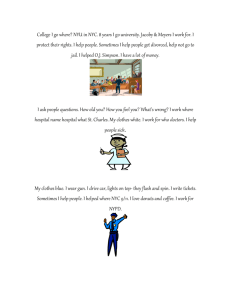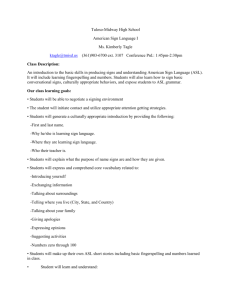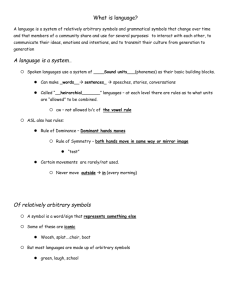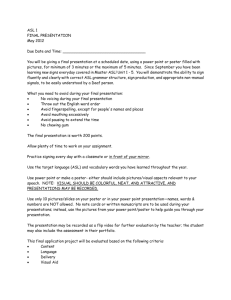Comparison of ASL and Other Sign Languages of Other Countries
advertisement
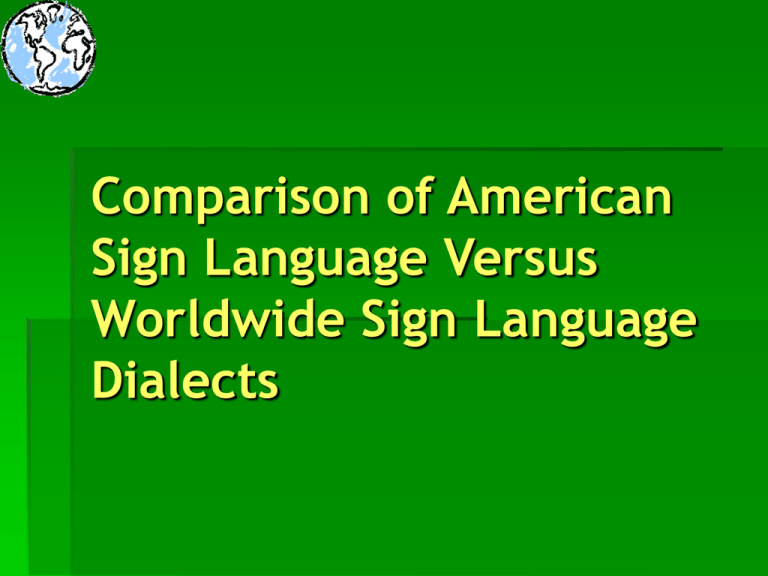
Comparison of American Sign Language Versus Worldwide Sign Language Dialects Introduction Title: Comparison of American Sign Language Versus Worldwide Sign Language Dialects Target Audience: Adults in the age bracket of 25-55 The goal of this project is to provide an understanding regarding the nature of deaf communication in various countries worldwide with the focus on America. Myths and Facts About Sign Languages Myths Sign languages are universal. People will understand other countries’ sign languages. All sign languages have the same grammatical structures and rules. Facts Sign languages in each country have their own dialect. Sign language dialects of each country will differ from region to region. Sign languages will not be completely understood or clear to foreigners who use sign language. Influences on Sign Languages The majority of sign languages in different countries were influenced by the French Sign Language system. Many countries had their own signing system prior to the exposure of FSL. Many countries modified some of the FSL and incorporated their sign language and the FSL into a complex language. ASL and Sign Languages of Other Countries ASL A complete and complex visual-spatial, natural language used by native users. Has no grammatical similarities to English. ASL is used and cherished by the Deaf community. There are not many documentations about ASL. Other Countries’ SL A complete and complex visual-spatial, natural language used by native users. Has no grammatical similarities to spoken languages of their own country. Sign languages of each country is used and cherished by the Deaf community. There are not many documents about sign languages in other countries. ASL and Sign Languages of Other Countries ASL It has its own grammatical structures: Syntax Semantics Pragmatics Morphology Phonology It contains gestures, nonmanual markers, classifiers, fingerspelling, etc. Other Countries’ SL Sign languages of each country have their own grammatical structures: Syntax Semantics Pragmatics Morphology Phonology Each sign languages contain gestures, non-manual markers, classifiers, fingerspelling, etc. Differences Between ASL and Sign Languages of Other Countries Signs used for expressing words and the manual alphabet are different from ASL. Some signs that are acceptable in some countries may be offensive in other countries. The structures and rules of the languages will vary from country to country. Japanese Sign Language Fingerspelling in JSL was not introduced until the early 20th century. Fingerspelling is influenced by Spain, France, and the United States. Older folks don’t know fingerspelling and numerals. It is not standardized like ASL. JSL rely on mouthing the words for clarification; whereas ASL uses initial letters of the English words or fingerspelling for distinguishment. Canada The dialect is very different from ASL in the United States and has regional differences in Canada from east to west. Most signers from eastern Canada use ASL, but with some British Sign Language vocabulary. Structurally and grammatically distinct from Quebec Sign Language (LSQ). Auslan Auslan recently was pulled from the words Australian Sign Language, but the language is not new. It is very complex in grammar and lexicon. The language is not purely gestural. Some signs are iconic, but it is mostly arbitrary; similar to ASL. Mexican Sign Language LSM and ASL are complete different languages. Strongly influenced by Spanish vocabulary and initialization. LSM uses more initialization for clarification compared to ASL. It is not seen as a negative strategy, nor is it viewed as “hearing” signs like that in ASL if a signer used initialized signs borrowed from English words. Summary of Different Sign Languages Sign languages are not universal as many people think. Each sign languages have their own grammatical structures and rules. People will not be able to understand sign languages of other countries no matter how fluent they are in their own sign language unless they learn that language. Each sign language dialect is as unique and complex as spoken languages. References Nakamura, Karen (2002) “About Japanese Sign Language.” Website. <http://www.deaflibrary.org/jsl.html> WA Deaf Society. 25 July 2002. The Western Australian Deaf Society Inc. 30 October 2002 <http:www.wadeaf.org.au/index.shtml> References continued American Sign Language: A Language of USA. July 2002. Ethnologue: Languages of the World, 14th Ed. Dec. 2001 <http://www.ethnologue.com/show_language.asp?_c ode=ASE> Faurot, Karla, Dianne Dellinger, Andy Eatough, and Steve Parkhurst. The Identity of Mexican Sign as a Language. June 1999. <http://www.sil.org/mexico/lenguajes-designos/G009i-Identity-MFS.pdf>


